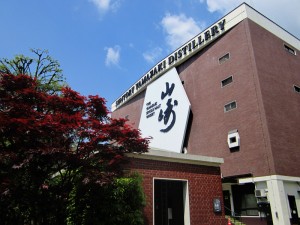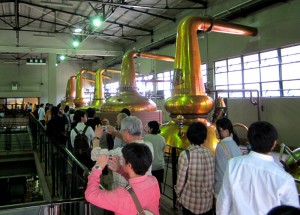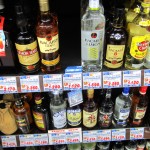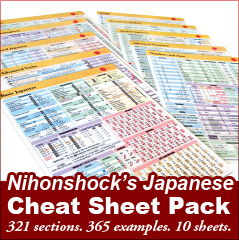Discovering Japanese Whisky
When most people think of Japan and alcohol, they think of rice wine sake. But Japan is also a world-class producer of malt whisky. If you enjoy a good Scotch whisky (Japanese whisky is made in the Scottish style), but haven’t yet tried any from Japan, you’re really missing out! Recently (especially since about 2010), Japanese whiskys have even come out on top of prestigious Scottish brands in blind taste tests.
The leading whisky producer in Japan is Suntory, which operates two distilleries: Yamazaki (
Yamazaki
 Yamazaki is Suntory’s flagship whisky, which is widely available in Japan everywhere from izakayas to convenience stores. The Yamazaki distillery has access to some of the best water in Japan and utilizes 12 stills (six for the first distilling and six for the second), each with a different design; this is a large number compared to most Scottish distilleries and means they can produce many different variations of “new make” (the colorless spirit that goes into casks for aging).
Yamazaki is Suntory’s flagship whisky, which is widely available in Japan everywhere from izakayas to convenience stores. The Yamazaki distillery has access to some of the best water in Japan and utilizes 12 stills (six for the first distilling and six for the second), each with a different design; this is a large number compared to most Scottish distilleries and means they can produce many different variations of “new make” (the colorless spirit that goes into casks for aging).
Like most other distilleries, imported oak casks which were previously used once to age bourbon are used to mature most of the whisky, but Yamazaki also utilizes exotic casks including sherry, Japanese oak (mizunara) and umeshu (plum liquor) casks. The latter is used to age whisky found in my personal favorite: Hibiki (a blended whisky).
Other producers in Japan
Nikka is another company that makes some excellent Japanese whisky, notably Yoichi (
Kirin produces a whisky called Fuji Sanroku (
In addition, there are a number of other smaller, local distilleries around Japan, but the lion’s share of the market is dominated by the brands mentioned in this blog (especially Suntory).
Touring a Japanese distillery
 As a fan of Suntory’s lineup, I recently traveled out to Yamazaki to take a tour of their facilities. It’s a quick and easy train ride from either Osaka or Kyoto and about a 5-7 minute walk from the station. Although a good understanding of Japanese will make the tour much more informative, the distillery does offer English-language accommodation in the form of a headset with numbered recordings and an English pamphlet.
As a fan of Suntory’s lineup, I recently traveled out to Yamazaki to take a tour of their facilities. It’s a quick and easy train ride from either Osaka or Kyoto and about a 5-7 minute walk from the station. Although a good understanding of Japanese will make the tour much more informative, the distillery does offer English-language accommodation in the form of a headset with numbered recordings and an English pamphlet.
There is a free guided tour which is available daily throughout the year. At the end, you get to sample some of the regular Yamazaki single malt (not the premium aged stuff). If you go through the Japanese-language site, you’ll find various seminars that are offered throughout the year. These seminars offer additional content and usually a wider variety for the tasting portion, but expect to pay a bit for these (about 1500 yen).
 If all you want to do is try some of Suntory’s fine whiskys, you don’t need a tour or seminar. Just head to the gift shop and you’ll find a tasting counter where you can order a 15ml splash of anything they offer. Prices mostly range from 100 to 500 yen for a tasting, but some of the high end whiskys go up to 2400 yen (Yamazaki/Hakushu 25-year, Hibiki-30 year). You can also taste a wide selection of non-Suntory brands like Macallan and Glenfiddich, even Canadian whiskys and American Bourbon.
If all you want to do is try some of Suntory’s fine whiskys, you don’t need a tour or seminar. Just head to the gift shop and you’ll find a tasting counter where you can order a 15ml splash of anything they offer. Prices mostly range from 100 to 500 yen for a tasting, but some of the high end whiskys go up to 2400 yen (Yamazaki/Hakushu 25-year, Hibiki-30 year). You can also taste a wide selection of non-Suntory brands like Macallan and Glenfiddich, even Canadian whiskys and American Bourbon.
Getting Japanese Whisky Outside of Japan
The difficulty of obtaining Japanese whisky outside of Japan is a problem I pray will be resolved soon. Last December, I was overjoyed to see Hibiki 12-year at my local CostCo, but it has since disappeared.
Perhaps that will soon change. Japanese whisky has been featured recently on TV news and business programs, and last year Suntory purchased Jim Beam, which could expand their options for international distribution.
On a side note…
Booze in Japan is uber-cheap! I’m talking half-price or less of what you would pay in the US. Check out these numbers!!! (Note that the standard bottle size in Japan is 700ml, which is a shot smaller than the 750ml bottles which probably populate your local liquor store)
You want a bottle of black label? That’ll be $20. Gold label? 45 bucks! …somebody pinch me! Scotch seems to be the best value relative to US prices, but vodka and rum are also very affordable. These pictures were taken at the Nagoya station Bic Camera, which was the cheapest retailer I found. Other locations tended to be 10-15% more expensive.
So remember this: if you’re traveling to Japan, don’t bother picking up any scotch at the airport duty-free shop. You’re almost certainly better off buying it in Japan.
How much duty-free liquor can you take home from Japan?
In the case of the US or Canada, you’re allowed 1.14 liters (= 40 ounces) of spirits. I brought back a 700ml, two 180mls and two 50ml minis for a total of 1.16 liters. Close enough.
For the record, if you’re a beer person you could bring back a 24-pack, or you oenophiles can take 1.5 liters (two regular bottles) of wine. However, you only get to bring one kind of liquor with you; spirits OR beer OR wine.
If you’re in another country and happen to know what the limit is, please leave a comment for others. ![]()
Well, that’s all for this post, thanks for reading. And now…














Very good article ! I would like to give more information about getting japanese whisky outside of Japan. Our online shop http://www.uisuki.com/en/ is dedicated to japanese whisky and other alcohols of Japan, based in France we can ship all over EU.
Actually we really would like to be able to ship in the US but to be honest it’s really hard due to very complicated customs regulations and taxes.
Suntory is already distributed in USA, but prices are very high !
Nikka has the ambition to get into the US market and will be soon arriving.
Good day
by: Nicolas Rua, May 21st at 11:44 pm